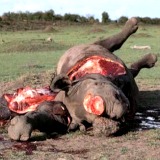Masai Mara National reserve
The Masai Mara National Reserve is a large game reserve in southwestern Kenya that forms the northern continuation of the Serengeti National Park game reserve in Tanzania.
This is a Reserve and not a National Park that is owned by the Masai people in whose language "Mara" means "spotted".
The Masai Mara National Reserve is famous for its annual migration of wildebeest, zebras and Thomsons gazelles from the Serengeti plains every year from July to October.
These three species are also resident in the reserve.
The Sekenani gate in the East leads into the rolling Ngama hills.
Here you should be able to see plenty of animals along the tracks off the main access road including warthogs, lions, elephants and buffaloes.
This habitat is favored by antelope like Grants gazelle, impalas and the common eland.
Do you know how impalas protect themselves from predators?
The population of Black rhinos in the reserve was fairly numerous until 1960, but it was severely depleted by poaching in the 1970s and early 1980s, at one point dropping to a low of 15 animals.
Do you know what gruesome methods are used in rhino-poaching?
Since then the numbers have been slowly increasing to an estimated 40 animals at the moment.
The best place to see Black rhinos is where they are dispersed across the central Olmisigiyoi region in the reserve.
The migration
During the migration the vast herds of wildebeest are the dominant inhabitants of the Masai Mara National Reserve.
Around June or July of each year, these ungainly animals migrate north from the adjoining Serengeti plains in search of fresh pasture, and return to the south around October.
Waves of plains zebras arrive first.
They graze the tall grass stems and in the process expose the green, leafy grasses that are preferred by the wildebeest that follow them.
The migration is one of the most impressive natural events in the world, involving an estimated 1,300,000 wildebeest, 500,000 Thomsons gazelles, 97,000 topis and 200,000 zebras.
These migrants are followed along their annual, circular route by predators like lions and hyenas.
Did you know that African lions are the only cats with close-knit social groups?
Vultures and other scavengers enjoy the good pickings from the leftovers left behind.
The talek gate opens to the undulating grassland of the Posee and Burrungat plains.
Over the years herds of elephants destroyed the thickets in this area. This allowed grasses to proliferate in this terrain.
The result of that the western and central Mara area now is one of the best areas to see grazing animals like
- Coke hartebeest
- Thomsons gazelle
- Grants gazelle
The Masai Giraffe with the jagged spots on their bodies have two horns that are bony outgrowths of the male skull.
Interestingly the dominant male in the herd has spots tend that to be darker in color than those of other members of the herd.
The adult males usually reach around 6m in height while the females tend to be slightly shorter at around 5,5 meters.
There
is no seasonal breeding season for the Masai Giraffe. It is estimated
that 50 to75% of the calves die in their first few months due to
predation.
You will notice that many large termite mounds dot the landscape in this area. The derelict termite mounds serves as shelter for mongooses, jackals and hyenas.
The termite mounds also serves as lookout points for cheetahs.
Birdwatching is excellent in the Masai Mara National Reserve.
More than 470 species of birds have been identified in the park, many of which are migrants, with almost 60 species being raptors..
The lilac-breasted roller is the national bird of Kenya.
The steep Siria escarpment overlooks the Western reaches of the reserve.
Many mountain reedbucks, klipspringers and steenboks inhabit this area.
The Musiara marsh supports waterbucks, impalas and large herds of elephants.
Lions are very common in this area. The fiercely defended territories are popular because of the abundant antelopes and seasonal zebras and wildebeests in the area.
The Sand, Talek River and Mara River are the major rivers in the reserve.
The Mara River supports around 2000 hippos. There are a number of hippo pools along the river.
During the big migration the herds cross the Mara and Talek rivers at several points.
The many Nile crocodiles that bask on the sandbars of the river eat thousands of them.
Wildlife watching tip
All viewing must be done from a vehicle.
The reserve has unfortunately developed a reputation as a minibus circus during busy times.
This usually happens during the wildebeest migration.
Be careful to use only a reputable company with accredited guides and 4WD vehicles when you make your bookings.
The rainy season is in April to May and again in November. This can cause some areas of the reserve to be inaccessible.
The dry season is from July to October that is a good time to come and see the huge herds of migratory herbivores.
The warmest time of year is December to January with the coolest being June and July.

